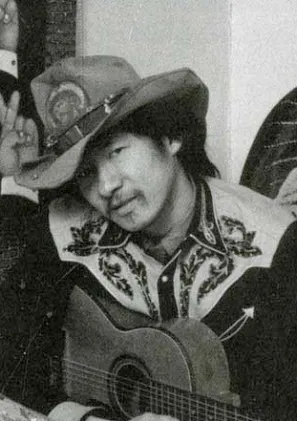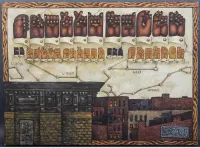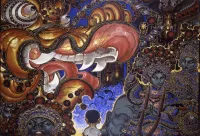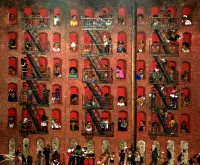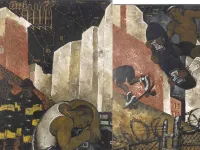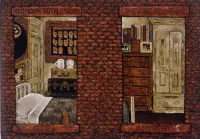Biography
1946 - 1999
“Every single Asian dude who went to high school or junior high during the era of John Hughes movies was called 'Donger,'”
– Martin Wong
Martin Wong was born on July 11, 1946 in Portland, Oregon and raised in Chinatown in San Francisco. After studying ceramics at college Wong became active in the San Francisco art scene as a member of the gay street performance group Angels of Light and also as a set designer for The Cockettes. In 1978, Wong moved to New York City and where he began to focus on his painting. There his career soared and soon gained national recognition. Largely self-taught as a painter, Wong’s work ranged from canvases of the decaying Lower East Side, to near-kitschy Chinatown depictions. His art tended to blend the decorative with the real, and also explored queer sexuality as well as ethnic identity. In his characteristic Fu Manchu mustache and cowboy hat, Wong became an influential artist in the downtown scene and a mentor to many young artists. Wong’s greatest fame came from his word and cityscape collaborations with one-time romantic partner, poet Miguel Pinero (1946-1988). Wong was also a vast collector. In 1994, he donated his 300 piece graffiti collection, one of the largest in the world, to the Museum of the City of New York. The same year Wong, suffering with HIV, returned to San Francisco. He died from an HIV-related illness at age 53 on August 12, 1999. In his obituary Wong was described by the New York Times as an artist “whose meticulous visionary realism is among the lasting legacies of New York's East Village art scene of the 1980s”.
1946 - 1999
“Every single Asian dude who went to high school or junior high during the era of John Hughes movies was called 'Donger,'”
– Martin Wong
Martin Wong was born on July 11, 1946 in Portland, Oregon and raised in Chinatown in San Francisco. After studying ceramics at college Wong became active in the San Francisco art scene as a member of the gay street performance group Angels of Light and also as a set designer for The Cockettes. In 1978, Wong moved to New York City and where he began to focus on his painting. There his career soared and soon gained national recognition. Largely self-taught as a painter, Wong’s work ranged from canvases of the decaying Lower East Side, to near-kitschy Chinatown depictions. His art tended to blend the decorative with the real, and also explored queer sexuality as well as ethnic identity. In his characteristic Fu Manchu mustache and cowboy hat, Wong became an influential artist in the downtown scene and a mentor to many young artists. Wong’s greatest fame came from his word and cityscape collaborations with one-time romantic partner, poet Miguel Pinero (1946-1988). Wong was also a vast collector. In 1994, he donated his 300 piece graffiti collection, one of the largest in the world, to the Museum of the City of New York. The same year Wong, suffering with HIV, returned to San Francisco. He died from an HIV-related illness at age 53 on August 12, 1999. In his obituary Wong was described by the New York Times as an artist “whose meticulous visionary realism is among the lasting legacies of New York's East Village art scene of the 1980s”.
Demography
Demography
Gender Male
Sexual Orientation Gay
Gender Identity Cisgender
Ethnicity Asian/Pacific Rim
Nations Affiliated United States
Era/Epoch AIDS Era (1980-present) Information Age (1970-present)
Field(s) of Contribution
Art
Art, Music, Literature & Theater
US History
Commemorations & Honors
Martin Wong Foundation Created By His Mother (2001)
Demography
Gender Male
Sexual Orientation Gay
Gender Identity Cisgender
Ethnicity Asian/Pacific Rim
Nations Affiliated United States
Era/Epoch AIDS Era (1980-present) Information Age (1970-present)
Field(s) of Contribution
Art
Art, Music, Literature & Theater
US History
Commemorations & Honors
Martin Wong Foundation Created By His Mother (2001)
Resources
Resources
Blake, Nayland, Rinder, Lawrence, and Scholder, Amy. In a Different Light: Visual Culture, Sexual Identity, Queer Practice. San Francisco: City Lights Books, 1995.
Bruce, Jeffrey. "Red Brick and Chain Link: The Urban Romance of Martin Wong." International Review of African American Art 16: 4 (2000): 37-41.
Frankel, David. "Martin Wong." Artforum 37.3 (October 1998): 117.
Hill, Hoe. "Martin Wong at P. P. O. W." Art in America 89.9 (September 2001): 148-49.
Lee, Elisa. "Urban Artist Depicts Chinatown Through American Eyes." Asianweek 15. 10 (October 29, 1993):1
Lord, Catherine, and Richard Meyer. Art & Queer Culture. New York: Phaidon, 2013.
McCormick, Carlo. "Village Voice." Artforum 38.7 (March 2000): 22-25.
Ramírez, Yasmin. "Martin Wong." Fresh Talk/Daring Gazes: Conversations on Asian American Art. Elaine K. Kim, Margo Machida, and Sharon Mizota, eds. Berkeley: University of California Press, 2003. 163-65.
Rubinstein, Raphael. "When Bad Was Good." Art in America 94.6 (June-July 2006): 83-87.
Schwabsky, Barry. "A City of Bricks and Mortar." Art in America 86.9 (September 1998): 100-105.
Taylor, Marvin J., ed. The Downtown Book: The New York Art Scene, 1974-1984. Princeton: Princeton University Press, 2006.
Trebay, Guy. "The Bricklayer's Art." Village Voice 43.21 (May 26, 1998): 30.
Valdez, Sarah. "Tales of Bohemian Glory." Art in America 93.6 (June-July 2006): 92-93.
Wong, Martin, Dan Cameron, and Amy Scholder. Sweet Oblivion: The Urban Landscape of Martin Wong. New Museum books, 1. New York: Rizzoli, 1998
Zamora, Jim Herron. "Martin Wong, San Francisco Artist." San Francisco Examiner (August 22, 1999): D5
http://en.wikipedia.org/wiki/Martin_Wong
http://www.nytimes.com/1999/08/18/arts/martin-wong-is-dead-at-53-a-painter-of-poetic-realism.html
https://www.visualaids.org/artists/detail/martin-wong
http://library.humboldt.edu/about/art/wong/legacy.html
https://www.artnews.com/feature/who-is-martin-wong-why-is-he-important-1234594299/
Resources
Blake, Nayland, Rinder, Lawrence, and Scholder, Amy. In a Different Light: Visual Culture, Sexual Identity, Queer Practice. San Francisco: City Lights Books, 1995.
Bruce, Jeffrey. "Red Brick and Chain Link: The Urban Romance of Martin Wong." International Review of African American Art 16: 4 (2000): 37-41.
Frankel, David. "Martin Wong." Artforum 37.3 (October 1998): 117.
Hill, Hoe. "Martin Wong at P. P. O. W." Art in America 89.9 (September 2001): 148-49.
Lee, Elisa. "Urban Artist Depicts Chinatown Through American Eyes." Asianweek 15. 10 (October 29, 1993):1
Lord, Catherine, and Richard Meyer. Art & Queer Culture. New York: Phaidon, 2013.
McCormick, Carlo. "Village Voice." Artforum 38.7 (March 2000): 22-25.
Ramírez, Yasmin. "Martin Wong." Fresh Talk/Daring Gazes: Conversations on Asian American Art. Elaine K. Kim, Margo Machida, and Sharon Mizota, eds. Berkeley: University of California Press, 2003. 163-65.
Rubinstein, Raphael. "When Bad Was Good." Art in America 94.6 (June-July 2006): 83-87.
Schwabsky, Barry. "A City of Bricks and Mortar." Art in America 86.9 (September 1998): 100-105.
Taylor, Marvin J., ed. The Downtown Book: The New York Art Scene, 1974-1984. Princeton: Princeton University Press, 2006.
Trebay, Guy. "The Bricklayer's Art." Village Voice 43.21 (May 26, 1998): 30.
Valdez, Sarah. "Tales of Bohemian Glory." Art in America 93.6 (June-July 2006): 92-93.
Wong, Martin, Dan Cameron, and Amy Scholder. Sweet Oblivion: The Urban Landscape of Martin Wong. New Museum books, 1. New York: Rizzoli, 1998
Zamora, Jim Herron. "Martin Wong, San Francisco Artist." San Francisco Examiner (August 22, 1999): D5
http://en.wikipedia.org/wiki/Martin_Wong
http://www.nytimes.com/1999/08/18/arts/martin-wong-is-dead-at-53-a-painter-of-poetic-realism.html
https://www.visualaids.org/artists/detail/martin-wong
http://library.humboldt.edu/about/art/wong/legacy.html
https://www.artnews.com/feature/who-is-martin-wong-why-is-he-important-1234594299/
